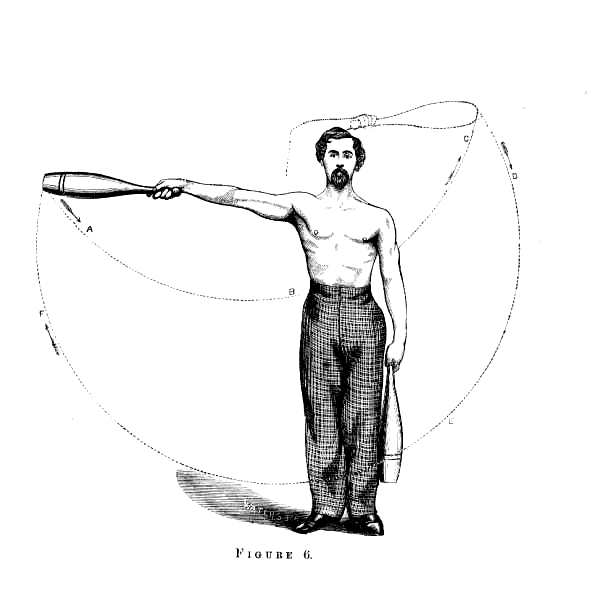This post first appeared on VictorianMartialArts.com and is republished with permission.
Indian clubs are a quintessential staple of any (real or imagined) scene depicting a Victorian Gymnasium or training hall. As they grow in popularity due to their current revival in fitness circles, it’s easy to miss the fact that these useful tools are not in fact Victorian -- nor are they Indian in origin.

The original "indian" clubs are in fact from the near east, in ancient Persia, where they are known as meels. They later spread to India, where they were incorporated into traditional Indian physical conditioning practice. It was from India that these tools were brought to Europe, and in true colonial style, were named for their place of discovery by the west rather than with any consideration to their origins or history.
Though their shape differs, it is easy when comparing modern indian clubs and club bells to the meel to see the similarity of function between both tools. In both Persian (continuing in modern Iran) and Indian culture they have both been specifically used for the conditioning of wrestlers and fighters and have an intrinsic connection to the combative arts. But what benefits does this classical form of conditioning have for modern fighters?
Grip and coordination
Using Indian clubs requires a certain amount of grip strength and the ability to modify and shift grip in space, much like the kettlebell. Rather than a fixed firm grip (which is absolutely necessary in certain exercises; try changing grip halfway through a max weight deadlift), indian clubs develop your ability to manipulate and change direction of an object during a movement. For fighters, this lends itself to development of fine motor control for manipulation of weapons (either your own or your opponent's during a disarming action), as well as the grip strength and flexibility necessary for throwing actions (when gripping fabric or your opponent's body). In martial arts, you are often only as strong as your grip, and rarely in a real fight or competition would what you are gripping be staying still.
Strength and flexibility
One thing I often find myself explaining to students is that there is no point in being strong in a very limited range of motion. For example, what would be the value of only being strong for the top six inches of your deadlift? Now, it’s often virtually impossible to train such a limited range of motion without the "benefit" of highly restrictive gym machines, but equally, it can be very easy to neglect the extremes of a range of motion when training without realizing it. Indian clubs -- when used correctly -- are an excellent way to increase and strengthen range of motion in the shoulder progressively in a way that stretching does not. Nobody wants to find out mid-armlock that their joints aren’t as strong as they thought, and even a relatively minor tweak to the shoulder or elbow can impede your training. These injuries generally happen at the extreme ends of a range of motion where we are weakest. Indian clubs work shoulder abduction and adduction, flexion and extension, and rotation in a progressive manner (with elements of core stabilization) to help protect and prepare the joints against the kind of stresses that are part and parcel of the actions martial artists perform, both armed and unarmed.
Mental focus
I’ll admit, I don’t use clubs as part of my regular training. I maybe play with them once a week. The reason I like them, however, is summed up in the word “play”. The coordination and focus required to practice with indian clubs, particularly in pairs, makes for a superb way to focus the mind and transition into a training attitude safely. It’s a way to switch on and engage with the body that makes for better and more mindful training, and give you an opportunity to feel out stiffness, injury and soreness prior to doing any heavy work.
Conclusion
I don’t subscribe to the "one true way" attitudes expressed by people who claim that one tool is the only tool needed to train the body. However, I find I will invariably mention their utility in my line of work as a fitness and fencing instructor as often their usefulness will naturally come up. When used as a supplementary warm up and injury prevention tool for martial artists, as they have been utilized throughout their long history, clubs are an invaluable tool for the modern fighter.
Further reading and where to buy
Note: For other Victorian Manuals on Indian club lifting, check out the VictorianMartialArts.com resources page.
- Kehoe, Simon D. The Indian Club Exercise with Explanatory Figures and Positions. New York: Frank McElroy, 1866. Click on the title to see a digital copy of the book.
- This video showing traditional Indian physical conditioning, including clubs, barbells, dumbbells and the mace (Gada).
- This video on the use of the Meel, and other traditional Persian conditioning techniques.
- This article on 3 Essential Movements with Indian Clubs, by Dave Hedges. Some modern Indian clubs instruction.
- My school has clubs from Purpleheart Armory; you can purchase them here.